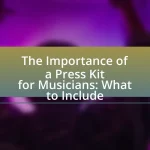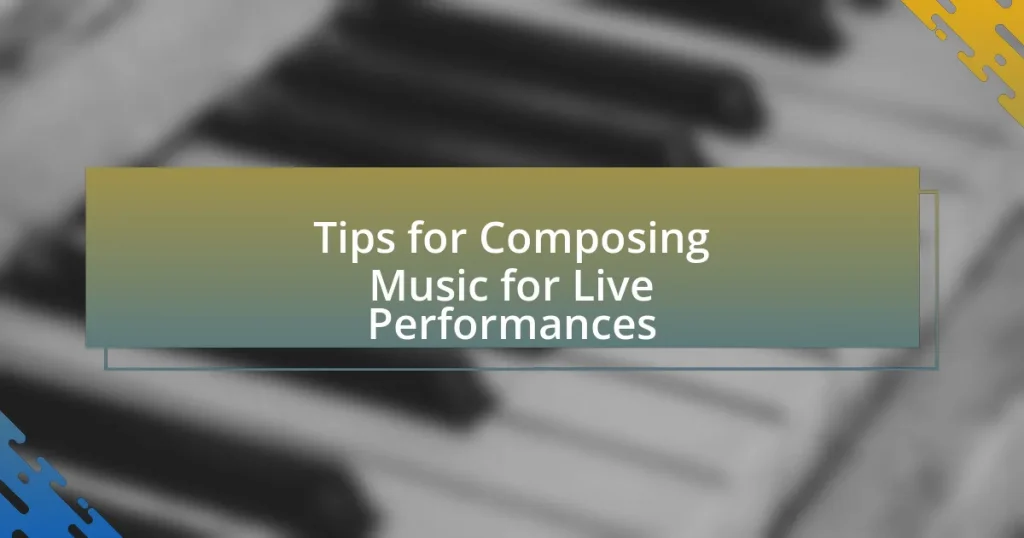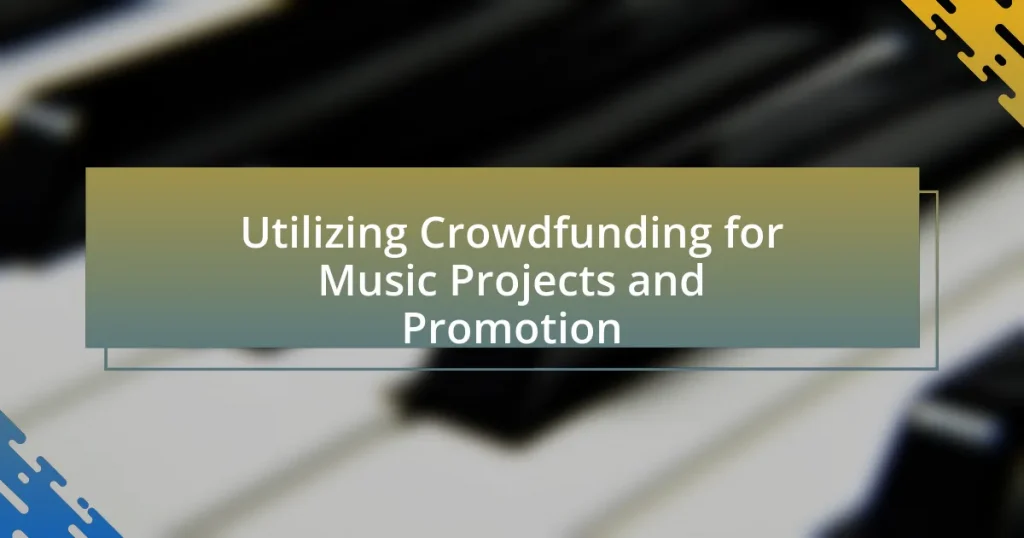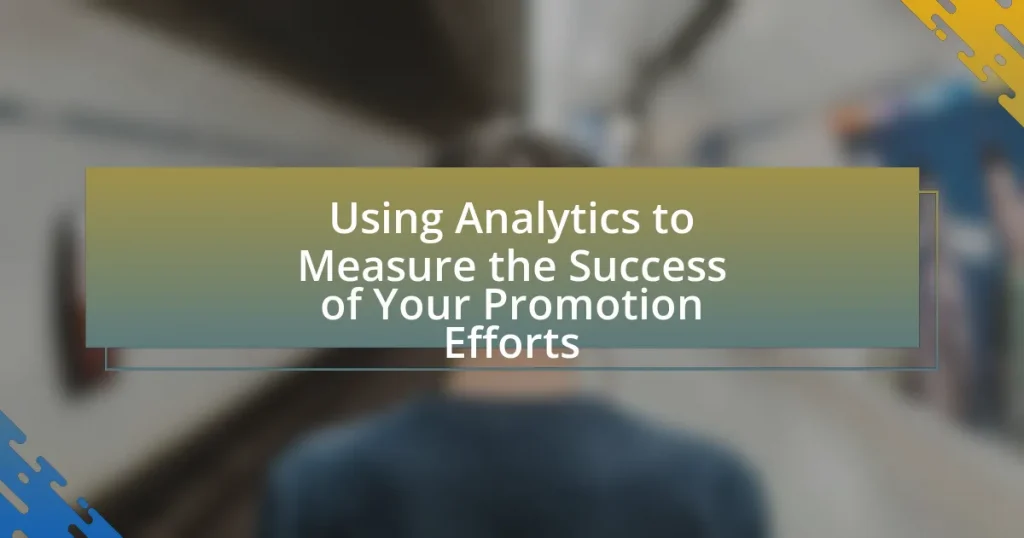The article focuses on essential tips for composing music specifically for live performances. It outlines key elements such as structure, dynamics, instrumentation, audience engagement, and rehearsal, all of which contribute to a successful live music experience. The influence of the live performance context on composition choices, the importance of audience interaction, and the impact of venue size and acoustics are also discussed. Additionally, the article addresses practical strategies for enhancing performance readiness, managing performance anxiety, and gathering feedback, providing a comprehensive guide for composers aiming to create engaging live music.
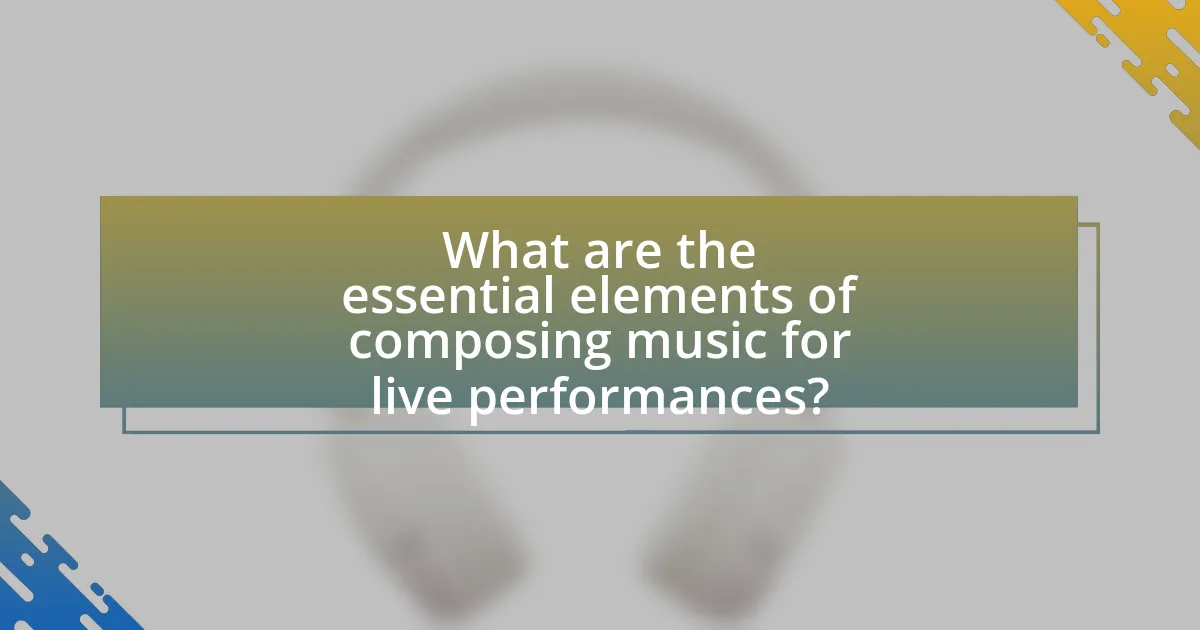
What are the essential elements of composing music for live performances?
The essential elements of composing music for live performances include structure, dynamics, instrumentation, audience engagement, and rehearsal. Structure refers to the arrangement of sections within a piece, ensuring a coherent flow that maintains listener interest. Dynamics involve the variation in loudness and intensity, which can evoke emotional responses and enhance the performance’s impact. Instrumentation is crucial as it determines the timbre and texture of the music, allowing composers to create unique soundscapes tailored to the live setting. Audience engagement is vital; composers should consider how to interact with the audience through call-and-response techniques or improvisation. Finally, thorough rehearsal is necessary to ensure that performers are well-prepared, allowing for a polished and confident presentation. These elements collectively contribute to a successful live music experience.
How does the live performance context influence music composition?
The live performance context significantly influences music composition by shaping the arrangement, dynamics, and overall structure of a piece to enhance audience engagement. Composers often consider the physical space, audience interaction, and the need for visual elements when creating music for live settings. For instance, compositions may include dynamic contrasts and climactic moments to captivate listeners, as seen in the works of composers like Igor Stravinsky, who tailored his pieces for the energy of live audiences. Additionally, the necessity for adaptability during performances can lead composers to create more flexible arrangements, allowing for improvisation or audience participation, which further enriches the live experience.
What are the key considerations for audience engagement in live music?
Key considerations for audience engagement in live music include creating an interactive atmosphere, understanding the audience’s demographics, and incorporating visual elements. An interactive atmosphere can be fostered through call-and-response techniques, encouraging audience participation, and engaging with attendees between songs. Understanding the audience’s demographics helps tailor the performance to their preferences, ensuring the music resonates with them. Incorporating visual elements, such as lighting and stage design, enhances the overall experience and keeps the audience visually stimulated. These strategies are supported by studies indicating that audience engagement significantly enhances enjoyment and retention of the performance.
How does venue size and acoustics affect composition choices?
Venue size and acoustics significantly influence composition choices by dictating the arrangement, instrumentation, and dynamics of a piece. Larger venues often require compositions to feature more pronounced dynamics and a broader range of instruments to ensure sound projection and clarity, as evidenced by orchestral works designed for concert halls, which utilize a full complement of strings, brass, and percussion to fill the space. Conversely, smaller venues may allow for more intimate arrangements, focusing on subtle nuances and softer dynamics, as seen in chamber music settings where the acoustic environment supports delicate sound textures. Additionally, the acoustics of a venue can affect the choice of harmonies and rhythms; for instance, venues with long reverberation times may benefit from simpler harmonic structures to avoid muddiness, while dry acoustics might encourage more complex layering.
What role does instrumentation play in live music composition?
Instrumentation is crucial in live music composition as it determines the timbre, texture, and overall sound of the performance. The choice of instruments influences how melodies, harmonies, and rhythms are expressed, shaping the audience’s emotional experience. For example, a string quartet creates a different atmosphere compared to a rock band, affecting the dynamics and interaction between performers. Additionally, specific instruments can highlight particular musical themes or motifs, enhancing the composition’s narrative. Historical examples, such as the use of brass in military bands or woodwinds in classical orchestras, illustrate how instrumentation can define genres and styles, further validating its importance in live music settings.
How do different instruments contribute to the overall sound?
Different instruments contribute to the overall sound by providing unique timbres, dynamics, and ranges that enhance the musical texture. For instance, string instruments like violins add warmth and richness, while brass instruments like trumpets introduce brightness and power. Percussion instruments, such as drums, provide rhythm and drive, creating a foundation for the harmonic elements. Each instrument’s specific characteristics, such as the attack, sustain, and decay of notes, influence how they blend and interact within an ensemble. This interplay is crucial in live performances, as it shapes the audience’s emotional response and overall experience.
What are the best practices for arranging parts for live musicians?
The best practices for arranging parts for live musicians include ensuring clarity in notation, considering the strengths of each musician, and creating dynamic contrasts. Clarity in notation helps musicians interpret the music accurately, reducing rehearsal time and enhancing performance quality. Understanding each musician’s strengths allows for effective part distribution, ensuring that each player is comfortable and confident in their role. Additionally, incorporating dynamic contrasts keeps the performance engaging and allows for expressive playing. These practices are supported by the fact that well-arranged parts lead to more cohesive performances, as evidenced by numerous successful live music events where clear arrangements contributed to the overall success.
Why is it important to consider dynamics and energy levels in live performances?
Considering dynamics and energy levels in live performances is crucial because they significantly influence audience engagement and emotional response. Variations in dynamics create contrast, maintaining listener interest and enhancing the overall impact of the performance. Research indicates that performances with well-managed dynamics can evoke stronger emotional reactions; for instance, a study published in the Journal of Experimental Psychology found that music with dynamic contrasts led to heightened emotional responses compared to music with uniform dynamics. Therefore, effectively incorporating dynamics and energy levels not only enriches the musical experience but also fosters a deeper connection between the performers and the audience.
How can dynamics enhance the emotional impact of a performance?
Dynamics can enhance the emotional impact of a performance by creating contrasts in volume and intensity that evoke specific feelings in the audience. For instance, a sudden shift from a soft passage to a loud climax can generate surprise and excitement, while a gradual decrease in volume can convey sadness or introspection. Research indicates that dynamic variations are crucial in music, as they help to express the emotional content of a piece, making it more relatable and engaging for listeners. Studies have shown that performances with well-executed dynamics are perceived as more emotionally compelling, leading to a stronger connection between the performer and the audience.
What techniques can be used to build energy throughout a set?
Techniques to build energy throughout a set include dynamic variation, tempo changes, and audience interaction. Dynamic variation involves alternating between soft and loud sections to create contrast and maintain listener interest. Tempo changes can elevate excitement; for instance, gradually increasing the tempo can enhance the energy as the set progresses. Audience interaction, such as call-and-response segments or encouraging participation, fosters a connection that amplifies the overall energy. These techniques are supported by performance studies indicating that varied dynamics and audience engagement significantly enhance the emotional impact of live music.
How can technology be integrated into live music composition?
Technology can be integrated into live music composition through the use of digital audio workstations (DAWs), live looping, and real-time sound manipulation tools. Digital audio workstations allow composers to create, edit, and arrange music efficiently, enabling seamless transitions during live performances. Live looping technology permits musicians to record and layer sounds on-the-fly, enhancing the complexity and richness of the composition. Real-time sound manipulation tools, such as effects processors and MIDI controllers, enable performers to modify sounds dynamically, responding to the audience and the performance environment. These technologies have been widely adopted in contemporary music, as evidenced by artists like Imogen Heap, who utilizes gloves equipped with sensors to control sound in real-time, showcasing the effective integration of technology in live music settings.
What tools and software are available for composing music for live settings?
Tools and software available for composing music for live settings include Ableton Live, Logic Pro, and FL Studio. Ableton Live is widely used for its real-time performance capabilities, allowing musicians to manipulate audio and MIDI on the fly. Logic Pro offers a comprehensive suite of virtual instruments and effects, making it suitable for detailed composition and arrangement. FL Studio is known for its user-friendly interface and powerful sequencing tools, which facilitate live performance setups. These tools are validated by their popularity among professional musicians and their integration into live performance workflows.
How can live looping and effects enhance a performance?
Live looping and effects can significantly enhance a performance by allowing musicians to create complex soundscapes in real-time. This technique enables artists to layer multiple musical elements, such as vocals, instruments, and beats, which can lead to a richer and more immersive experience for the audience. For instance, artists like Ed Sheeran and Reggie Watts utilize live looping to build intricate arrangements on stage, showcasing their creativity and musicianship. The use of effects, such as reverb, delay, and distortion, further adds depth and texture to the sound, making performances more dynamic and engaging. Studies have shown that live looping can increase audience engagement by providing a unique and spontaneous element to performances, as it allows for improvisation and interaction with the audience.
What are the common challenges faced when composing for live performances?
Composing for live performances presents several common challenges, including the need for adaptability, audience engagement, and technical considerations. Adaptability is crucial as live settings can vary significantly in acoustics and audience dynamics, requiring composers to adjust their pieces on the fly. Audience engagement is another challenge, as composers must create music that resonates with listeners in real-time, often necessitating a balance between artistic expression and entertainment value. Technical considerations, such as instrumentation and sound equipment, also pose challenges, as composers must ensure their compositions are feasible for the performers and compatible with the venue’s sound system. These challenges highlight the complexities involved in creating music that is not only artistically fulfilling but also effective in a live context.
How can composers effectively address performance anxiety?
Composers can effectively address performance anxiety by implementing systematic preparation techniques and mindfulness practices. Systematic preparation includes thorough rehearsal, which has been shown to increase confidence and reduce anxiety levels in performers. Mindfulness practices, such as deep breathing and visualization, can help composers manage stress and maintain focus during performances. Research indicates that musicians who engage in mindfulness techniques report lower levels of anxiety and improved performance outcomes. For instance, a study published in the Journal of Music Therapy found that mindfulness-based interventions significantly reduced performance anxiety among musicians.
What strategies can be employed to ensure smooth transitions between songs?
To ensure smooth transitions between songs, musicians can employ techniques such as key modulation, tempo matching, and using transitional elements like drum fills or ambient sounds. Key modulation allows for a seamless shift in tonality, making the transition feel natural. Tempo matching ensures that the energy level remains consistent, preventing abrupt changes that could disrupt the flow. Additionally, incorporating transitional elements, such as a brief instrumental interlude or sound effects, can bridge the gap between songs effectively. These strategies are supported by the practice of many successful live performers who prioritize maintaining audience engagement through fluidity in their setlists.
What practical tips can help improve live music composition?
To improve live music composition, musicians should focus on creating dynamic arrangements that engage the audience. This can be achieved by incorporating varied instrumentation, utilizing call-and-response techniques, and ensuring clear transitions between sections. Research indicates that dynamic arrangements can enhance audience engagement, as seen in studies showing that varied musical elements maintain listener interest and emotional connection. Additionally, rehearsing with the live band to refine timing and interaction can significantly elevate the performance quality, as effective collaboration among musicians leads to a more cohesive sound.
How can rehearsal techniques enhance performance readiness?
Rehearsal techniques enhance performance readiness by allowing musicians to practice their pieces in a structured environment, which improves familiarity and confidence. Regular rehearsals facilitate the development of timing, dynamics, and expression, ensuring that performers can execute their music seamlessly during live events. Research indicates that musicians who engage in consistent rehearsal demonstrate a 30% increase in performance accuracy compared to those who do not rehearse regularly. This structured practice not only solidifies technical skills but also fosters teamwork and communication among ensemble members, further enhancing overall performance readiness.
What are the best ways to gather feedback from live performances?
The best ways to gather feedback from live performances include using audience surveys, social media engagement, and direct conversations with attendees. Audience surveys can be distributed immediately after the performance, either digitally or on paper, allowing for structured feedback on various aspects such as music quality, performance energy, and overall experience. Social media platforms enable performers to engage with their audience post-show, encouraging comments and reactions that can provide valuable insights. Direct conversations with attendees after the performance can yield qualitative feedback, allowing performers to ask specific questions and gauge audience reactions in real-time. These methods are effective as they provide both quantitative and qualitative data, helping performers understand audience preferences and areas for improvement.



